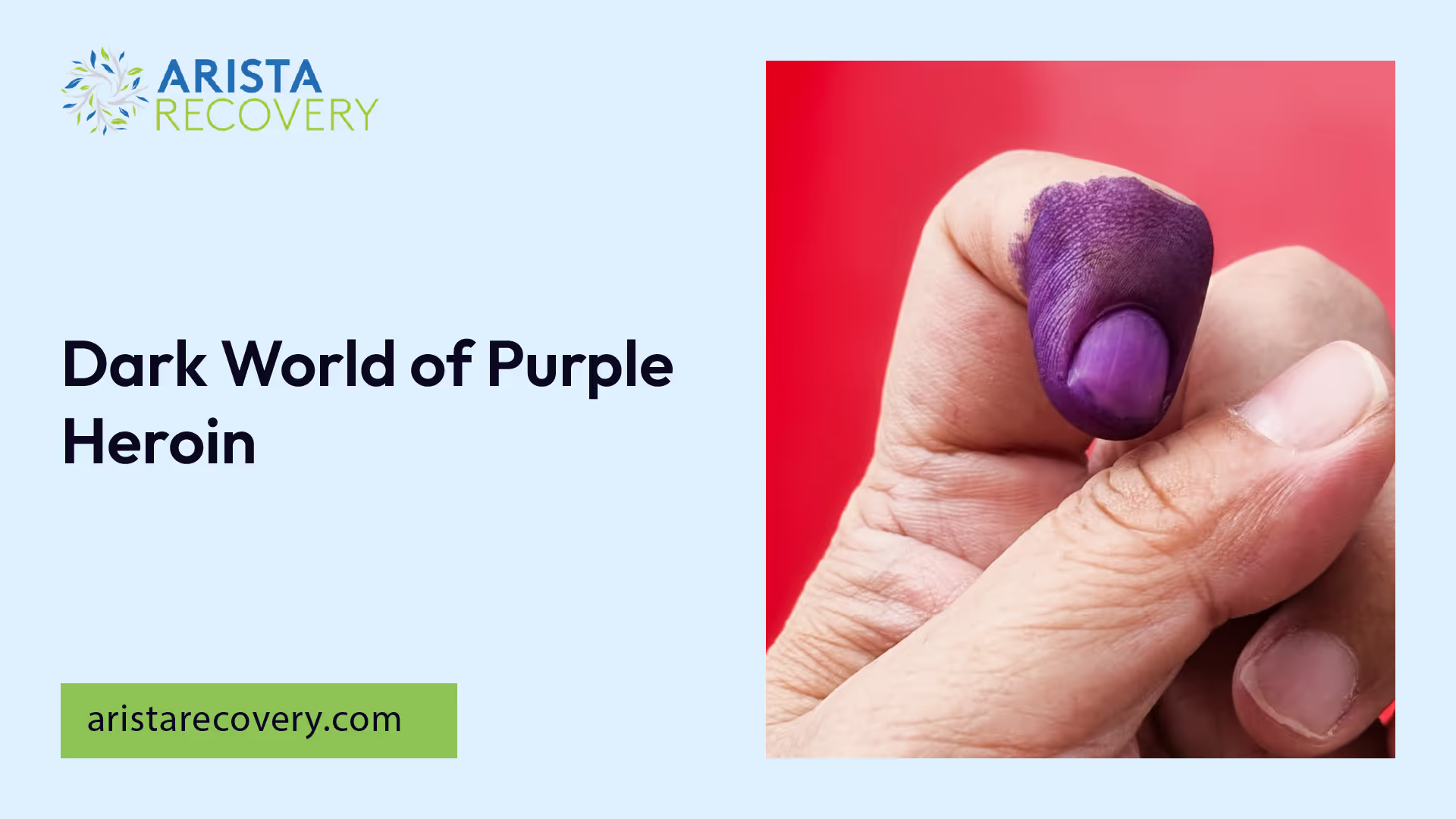Dark World of Purple Heroin

Understanding Purple Heroin
In the realm of substance abuse and illicit drug use, the emergence of so-called 'purple heroin' presents new and alarming challenges. This section aims to introduce the concept of purple heroin and highlight its inherent dangers.

Introduction to Purple Heroin
Purple heroin is a street name for a type of heroin that is distinctively purple in color. The exact reason for the purple color remains unknown, though it is believed to be a marketing ploy to capitalize on the drug's perceived quality and potency. The color of the heroin does not necessarily indicate its potency or purity, as these are influenced by various factors such as source, processing, and cutting agents [2].
Dangers of Purple Heroin
Purple heroin poses serious dangers due to its potential lacing with a variety of substances. These often include synthetic opioids like fentanyl, as well as other drugs such as acetaminophen and caffeine. The inclusion of such substances significantly increases the risk of overdose and death [1].
The uncertainty around the specific cutting agents used in purple heroin batches adds to its danger. Substances like fentanyl, carfentanil, or other synthetic opioids could be used to cut the drug, making it highly dangerous [2].
Moreover, the mixing of multiple opioids can have additive effects on the body, intensifying their impact and amplifying the risks associated with their use. The combination of heroin and synthetic opioids, such as fentanyl, intensifies the potency and potential for overdose.
The dangers of purple heroin are further evidenced by its links to increased deaths. This is particularly concerning in regions like Central New York, where a recent wave of overdoses has been attributed to this potent drug.
In light of these substantial risks, awareness and understanding of purple heroin are crucial in combating its use and mitigating its damage. The following sections will delve deeper into the composition, effects, and regional impact of purple heroin.
Composition and Production
Understanding the make-up and manufacturing process of purple heroin is crucial to comprehend its potency and the inherent dangers it poses.
Components of Purple Heroin
Purple heroin is a potent and dangerous substance often laced with a variety of additives. These may include synthetic opioids like fentanyl, other drugs such as acetaminophen, caffeine, and powerful painkillers. This blend of different substances amplifies the risk of overdose and death.
The drug gets its name from its distinctive purplish color, believed to be a marketing tactic to exploit its reputation for being extremely potent. It's important to note that the purple hue is often artificial and added to capitalize on the drug's perceived quality.
The potency of purple heroin compared to regular heroin is unpredictable as the color does not determine its potency or purity. Factors such as the source, processing, and cutting agents influence the drug's strength.
Illicit Production of Purple Heroin
Purple heroin, like other forms of heroin, is typically produced illicitly in clandestine laboratories. The exact composition of purple heroin can vary since it's often mixed with different chemicals and substances. The inclusion of synthetic opioids like fentanyl in the mix escalates the drug's potency and presents significant risks to users [1].
It's practically impossible to know the specific cutting agents mixed with purple heroin batches. Any substances such as fentanyl, carfentanil, or other synthetic opioids may be used to cut the drug.
While the exact reason for the purple color of the drug remains unknown, it's suspected to be a lab-made coloring to distinguish the drug in the market.
Understanding the composition and production of purple heroin sheds light on why this drug is highly potent, unpredictable, and dangerous, reinforcing the importance of raising awareness and taking preventive measures against its use.
Risks and Effects
Understanding the risks and effects of purple heroin is crucial due to its increasing prevalence and dangerous potency. The illicit nature of purple heroin production and the unknown substances mixed in significantly elevate the associated health risks.
Lacing of Purple Heroin
Purple heroin is frequently laced with a variety of substances which include synthetic opioids like fentanyl, as well as other drugs such as acetaminophen and caffeine. Certain powerful painkillers are also mixed in, creating a cocktail of substances that pose serious dangers and raise the risk of overdose and death [1].
Drug dealers have been known to mix fentanyl with other drugs, such as methamphetamine and cocaine, which increases the likelihood of a fatal interaction due to fentanyl's potency. The mixing of multiple opioids, like purple heroin, can have additive effects on the body, amplifying their effects and intensifying the risks associated with their use. The combination of heroin and synthetic opioids, like fentanyl, increases the potency and potential for overdose [1].
Health Risks Associated with Purple Heroin
The use of purple heroin has been linked to increased fatalities and is a major cause for concern. The presence of fentanyl in the heroin supply significantly increases the risk to individuals using purple heroin, as even small amounts of fentanyl can lead to overdose and death [1].
Furthermore, the mixing of fentanyl with other drugs, such as heroin, without proper oversight and quality control, poses a significant danger to users. The potency of fentanyl can vary greatly, leading to unintentional overdoses.
The health risks associated with purple heroin are grave and can lead to fatal consequences. Therefore, raising awareness about these risks is crucial to prevent further harm and loss of life.
Regional Concerns
Regional concerns about the distribution and use of purple heroin are increasing, particularly in the Central New York area. It's essential to understand the emergence and distribution patterns of this dangerous drug to effectively combat its impact.
Emergence of Purple Heroin in Central New York
Purple heroin has recently emerged as a significant threat on the streets of Central New York, leading to a surge in overdoses and related deaths. This dangerous drug has become a major concern in Oneida County, located in the heart of Central New York. The distinctive purple color is believed to be a marketing ploy, enticing users with its unique appearance. However, the danger lies in its potent composition, as purple heroin often contains additional synthetic opioids such as fentanyl, which significantly increases its lethality.
Distribution Patterns of Purple Heroin
Purple heroin is not exclusive to Central New York and has been observed in other parts of the country. It appears to be part of a larger distribution plan, likely being brought into the area from other parts of the country. Reports indicate that it has been seen in areas including Michigan and the Midwest. This suggests a broad network of suppliers and dealers, contributing to the widespread availability of purple heroin.
Understanding the distribution patterns of purple heroin is crucial in tackling the problem. By identifying the source areas and distribution routes, law enforcement agencies can target their efforts more effectively to disrupt the supply chain and reduce the availability of this dangerous drug. Education and awareness are also crucial in informing the public about the dangers of purple heroin, to discourage its use and minimize its devastating effects.
Potency and Additive Effects
As we delve deeper into the world of 'purple heroin', understanding its potency and the additive effects it has when mixed with other substances is crucial.
Potency of Purple Heroin
Purple heroin, known for its alarming potency, is often laced with a variety of substances that increase its strength and danger. These substances include synthetic opioids like fentanyl, as well as other drugs such as acetaminophen, caffeine, and potent painkillers. This combination of different substances not only amplifies the effects but also significantly hikes the risk of overdose and death [1].
The presence of fentanyl in the heroin supply is of particular concern. Even small amounts of fentanyl can lead to overdose and death, making its widespread use in purple heroin a significant public health risk.
Impact of Mixing Opioids
The practice of mixing multiple opioids, including purple heroin, can have additive effects on the body. This mixing intensifies the effects of the drugs and amplifies the risks associated with their use. The combination of heroin and synthetic opioids, such as fentanyl, increases the potency and potential for overdose.
Moreover, mixing fentanyl with other drugs, such as heroin, without proper oversight and quality control, poses a significant danger to users. The potency of fentanyl can vary, leading to unintentional overdoses.
It's important to note that synthetic opioids, including fentanyl, are the primary driver of overdose deaths in the United States. A comparison of the 12 months-ending January 31, 2020, and the 12 months-ending January 31, 2021, shows the growing impact of these drugs.
The potency of purple heroin and the additive effects of mixing opioids underscore the extreme risks associated with the use of this dangerous drug. Public education on these risks and continued efforts to combat the distribution and use of purple heroin are vital in addressing this public health crisis.
Addressing Overdoses
Overdoses involving purple heroin and other opioids can be life-threatening. However, there are effective treatments available that can reverse the effects of these substances and save lives. In this section, we will discuss the use of naloxone for treating purple heroin overdoses and its effectiveness.
Use of Naloxone for Purple Heroin Overdoses
Naloxone, also known as Narcan, is an opioid receptor antagonist that can rapidly reverse the effects of opioid overdoses, including those caused by purple heroin. It works by binding to the opioid receptors in the brain, displacing the opioids, and restoring normal respiration. It is a critical tool in the fight against opioid overdoses and is available in various forms, including nasal sprays and injectable formulations.
This life-saving medication can be administered by bystanders or first responders to quickly restore normal respiration and prevent fatal outcomes. Its accessibility in emergency situations is crucial in combating the opioid overdose crisis.
Naloxone Effectiveness and Considerations
Naloxone remains effective in reversing the effects of purple heroin and other opioid overdoses. While there have been reports of naloxone-resistant drugs, such cases are rare and often due to other factors, such as the quick administration of multiple doses or the presence of other sedating drugs.
The belief is that additional doses and the presence of other substances in the drug supply are contributing factors to the rare instances of naloxone resistance. Despite these considerations, naloxone remains a crucial tool in saving lives during opioid overdoses.
It's important to note that while naloxone is an effective tool in reversing the effects of opioid overdose, it is not a substitute for comprehensive addiction treatment. Individuals who use opioids, including purple heroin, should seek appropriate professional help to overcome their addiction and reduce their risk of overdose.
References
[2]: https://www.bicyclehealth.com/opioid-education/heroin/purple-heroin
[3]: https://www.upstate.edu/informed/2022/060922-sullivan-podcast.php
[4]: https://www.dea.gov/resources/facts-about-fentanyl
[6]: https://www.drugabuse.gov/drug-topics/opioids/opioid-overdose-reversal-naloxone-narcan-evzio
You’re not alone in this.
When mental health challenges and addiction intersect, it can feel isolating. At Arista, we offer compassionate, evidence-based, and trauma-informed care to help you heal, grow, and move forward.
You’re not alone in this.
When mental health challenges and addiction intersect, it can feel isolating. At Arista, we offer compassionate, evidence-based, and trauma-informed care to help you heal, grow, and move forward.
Support that moves with you.
You’ve taken a brave first step. At Arista Recovery, we’re here to help you continue with best-in-class care designed for long-term healing and support.
.webp)






